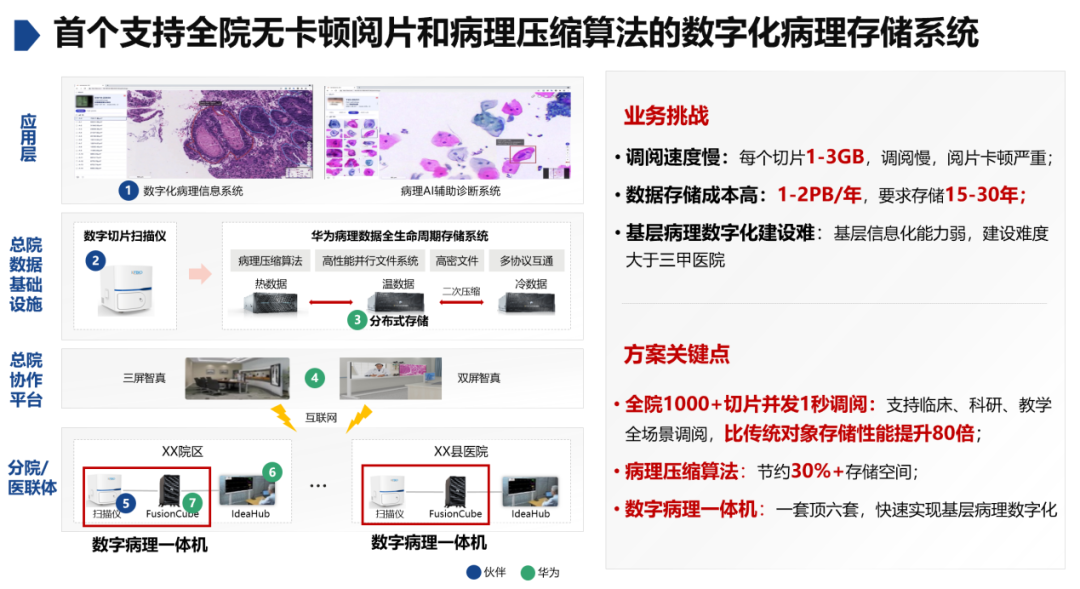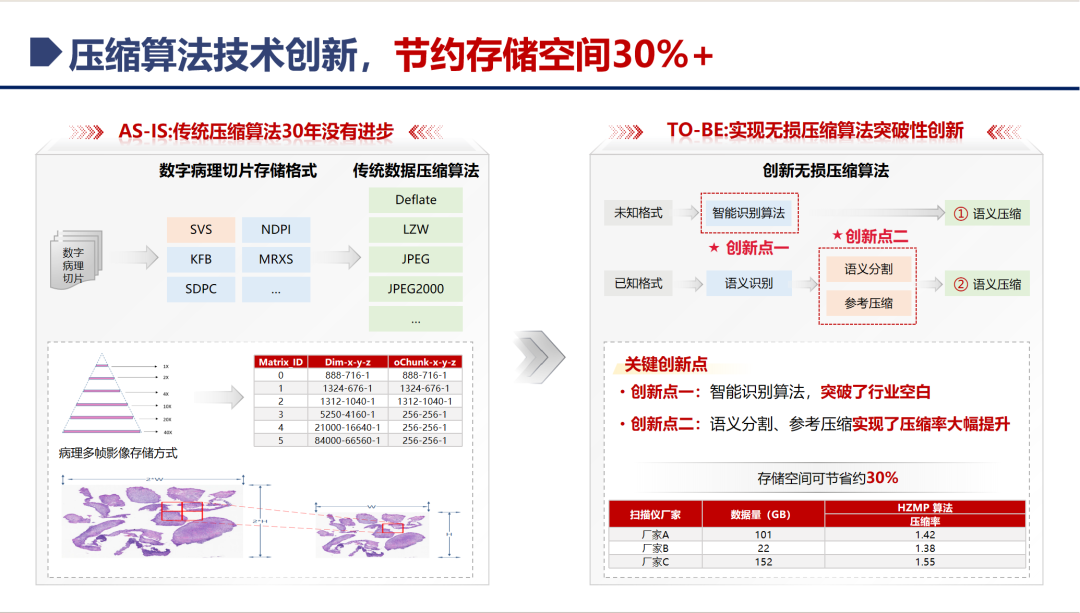 The world's first digital pathology storage system supporting hospital-level film Reading and secondary compression algorithms
The world's first digital pathology storage system supporting hospital-level film Reading and secondary compression algorithms
& ldquo; Doctor, have my pathological results come out? ”
& ldquo; Doctor, the clinic said that the operation should be decided according to the pathological results. How long will it take? ”……
such problems emerge one after another. To be honest, doctors are also very upset & hellip;& hellip; Digital pathology has brought a turning point to solve this problem. However, there are also some obstacles in the process of pathology Digitization: because the single slice file after pathology digitization is too large, each slice reaches 1-3GB, which is equivalent to the size of a high-definition movie., is thousands of times the traditional single PACS image file, the traditional solution uses object storage, in a small number of scientific research application scenarios may be able to cope with, but when pathology, teaching, scientific research, when both clinical and AI applications (small models and large models) begin digital reading, the traditional object storage solution has the problem of slow reading speed, and mosaic and delayed delay of tens of seconds often occur, it seriously hinders doctors' reading and diagnosis, and can not realize the real digital pathological reading at the department level or even at the hospital level.
In addition, the pathology department produces about 6,000 digital slices every day, which leads to the hospital's need to purchase 2PB of storage equipment to store such a large amount of data every year, and these data occupy a large amount of valuable cabinet resources of the hospital. At the same time, & ldquo; Difficulty in data sharing & rdquo; Is also a big problem faced by hospitals: Cut large film files and slow transmission lead to difficulties in remote pathology and regional pathology.
 & ldquo; One thousand pieces per second & rdquo; Not stuck
& ldquo; One thousand pieces per second & rdquo; Not stuck
in order to improve the efficiency of reading large amounts of digital slices, the technology of & ldquo; Distributed parallel file client (DPC)& rdquo; Does not require upgrading the network and reading client, IT can effectively protect the existing IT investment in the hospital. DPC technology is introduced into pathological digital slice reading. The system can automatically match layers according to browsing requirements when reading slices, it really realizes & ldquo; You can see wherever you want anytime and anywhere without waiting. It is very smooth & rdquo;, and the same slice supports multiple people reading films at the same time, and supports millions of non-stuck reading requirements including clinical, scientific research, teaching and other scenarios, the ability to read films is 80 times higher than that of traditional object storage, and the problem of traditional object storage being stuck and mosaic in large-scale digital pathology diagnosis scenarios is completely eliminated.
 & ldquo; Lossless pathological compression algorithm + high-density Hardware & rdquo; Cost reduction
& ldquo; Lossless pathological compression algorithm + high-density Hardware & rdquo; Cost reduction
the average size of traditional pathological images after compression is still close to 1GB, and the correlation of pathological image characteristics cannot be fully utilized. On the basis of fully studying the characteristics of Pathological Data, & ldquo; Secondary lossless compression algorithm for Pathological Data & rdquo; Intelligent identification of unknown formats, semantic segmentation of known formats, reference compression and other technologies, greatly improve the compression rate of pathological sections, break through the industry blank, and save more than 30% of storage space. With the design of high-density proprietary hardware, it allows less space to store more data, and a single cabinet can store 11PB of pathological data, helping the hospital save 73% of the room space, which is enough to hold pathological data for more than 5-15 years.. In the current situation of tight data center space and high storage costs, storage compression and high-density technologies can save storage investment costs and data center space consumption, it has found a high-quality & ldquo; Destination & rdquo; For a large number of pathological data in the future;.

Through & ldquo; Digital pathological storage system & rdquo; With the whole hospital-level film Reading and secondary compression algorithm, it helps the pathology department of Ruijin Hospital to complete digital intelligent transformation. In the 14th Five-Year Plan, the state mentioned the need to solve the problem of uneven distribution of high-quality medical resources, especially in the pathology industry. On the one hand, the key to the high quality development of public hospitals is the homogenization management. The construction of digital intelligent pathology department can help the digitization and business homogenization of head hospitals and branch districts; On the other hand, it can drive the digitalization of primary hospitals, improve the diagnostic level and the accessibility of high quality pathological resources for ordinary patients.
What is worth paying attention to is that top three hospitals & ldquo; One hospital and multiple districts & rdquo; Rapid development, large-scale construction of national regional medical centers and provincial regional medical centers, digital intelligent transformation of pathology department is an indispensable key ability to realize homogeneous management of pathology business. We hope & ldquo; The digital pathological storage system of the whole hospital-level film Reading and secondary compression algorithm & rdquo; it can help the construction of digital intelligent pathology department in top three hospitals, national regional medical centers and provincial regional medical centers, and copy & ldquo; Ruijin model & rdquo; To the whole country, contributing to Ruijin.
As one of the key disciplines of the hospital, pathology department has the international first-class pathological testing platform and strong soft power, and undertakes the massive pathological diagnosis from all over the country, with a total slice volume of over 1.5 million in the whole year. Facing the diagnostic needs of patients & ldquo; High efficiency, high accuracy and wide coverage & rdquo;, digital transformation is the inevitable development trend of the modernization of hospital pathology department.
The Department of Pathology of Ruijin Hospital, together with Huawei's data storage product line, has made a qualitative leap in digital pathology high-performance reading and data reduction technology based on Huawei OceanStor distributed storage, the key pain points of digital pathology are solved. After practical testing, even if up to 1,000 digital slicing requests are initiated at the same time, Huawei OceanStor distributed storage can quickly read data in 1 second without upgrading the network and reading client. At the same time, aiming at the problems of huge overall data volume and difficult storage, intelligent identification of pathological data is realized through digital pathology secondary compression algorithm, make the data compression ratio more than 30% in addition, with high-density hardware design, more data can be stored in less space and longer time, helped the hospital save 73% of the room space.. Digital pathology is based on the evolution of storage technology, accelerating the process of pathology digitization and helping to solve the problem of uneven distribution of pathological resources.
On May 28th, 2023, Ruijin hospital jointly released China's first & ldquo; Digital intelligent pathology & rdquo; And China's first white paper on the construction of digital intelligent pathology.



 Reprint
Reprint 